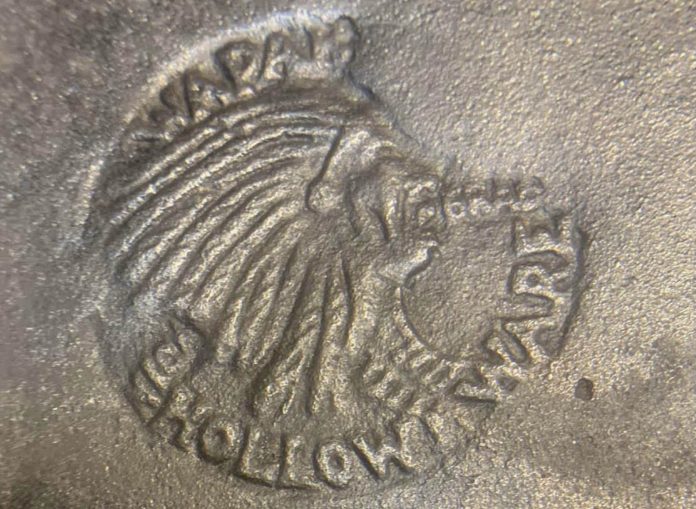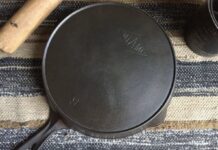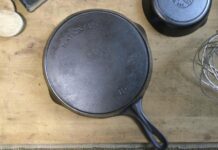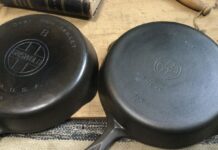One of the most sought-after pieces of antique cast-iron cookware is the Indian Head logo. The Wapak Hollow Ware Company manufactured them from the early 1900s to the mid-1920s. It’s a beautiful-looking logo, and I hope you consider yourself lucky if you are the current guardian of a Wapak Indian Head skillet or another piece of Wapak cookware.
In this article, you can learn about Wapak Indian Head ironware. And identify genuine Wapak ironware from imitation pieces.
Table Of Contents
- Characteristics of Wapak ironware with the Indian logo
- Buying guide for cast iron enthusiasts
- Identifying genuine and imitation Wapak Indian Head Hollow Ware
- Final thoughts
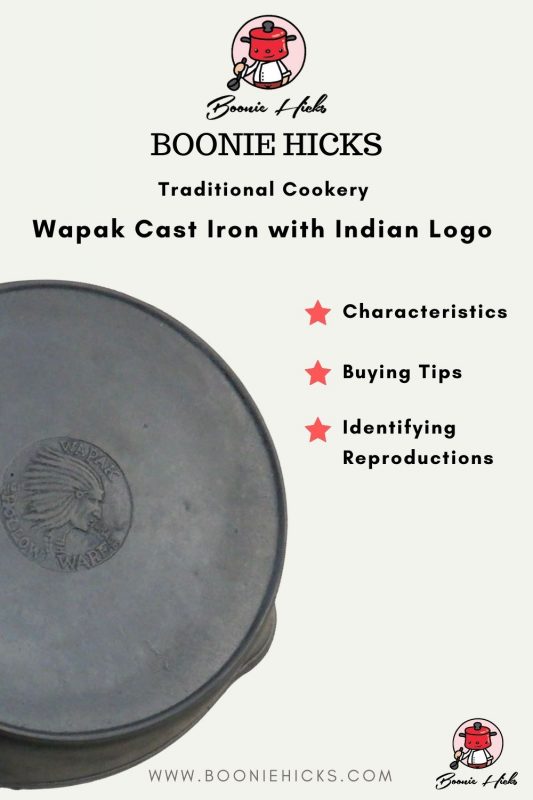
Wapak Indian Head Characteristics
Do you have a piece of hollowware with the Wapak Indian Head? You will probably notice the ironware is light and smooth and has fewer flaws than Wapak’s other ironware. The foundry workers undoubtedly took pride in making these pieces.
Fewer casting flaws
Wapak ironware often has characteristic casting flaws. And it’s not unusual to see regular skillets with indentations on the cooking surface. Or slight ripples on the base due to sand shifts during casting.
However, Indian-head cast iron skillets have fewer cast iron flaws than regular Wapaks. And it makes me wonder if the foundry took extra care and attention when producing hollowware with the famous logo. But remember that the Wapaks Hollow Ware Company still manufactured Indian-branded hollowware. So you can expect to find more faults in the casting compared to other manufacturers of the time.
Therefore, if your Indian Head cookware has a few indentations or casting bubbles in the iron, you have a perfectly normal Wapak. These flaws tend to be on the base and sides of the cookware. And for many Wapak collectors, these imperfections add to the brand’s charm.
High Grade Logo
I suspect the company sold its branded ironware at a premium compared to cookware sporting other Wapak logos. And this is no different if you are purchasing a vintage Wapak today. These skillets and other Indian-branded ironware are highly collectible and command a high price tag. But Wapak labeled these pieces High Grade for a good reason. Expect a lightweight pan with a very smooth cooking surface.
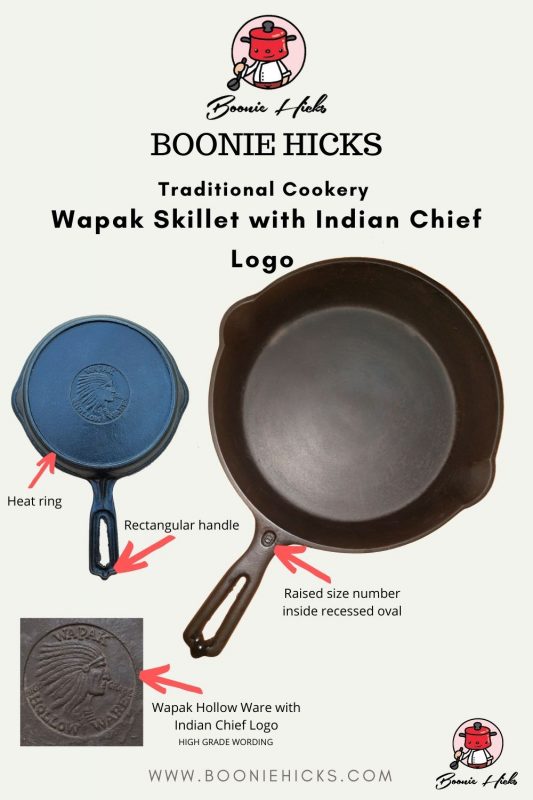
The Wapak Line Of Indian Head Ironware
However, coming across Wapak ironware with the Indian chief logo is relatively rare compared to other Wapak logos and manufacturers. The company produced several pieces of cookware using the Wapak Indian Chief marking. Including the following:
- Dutch Ovens
- Skillets
- Waffle Irons
- Griddles
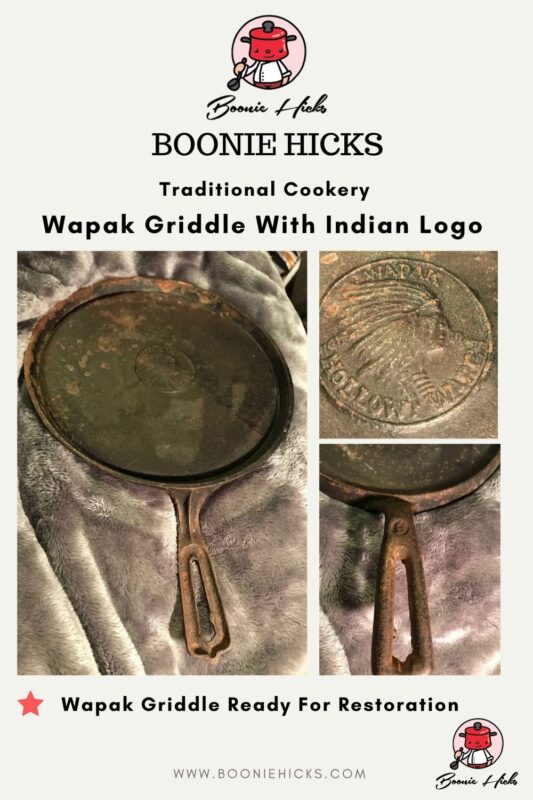
What To Look For When Purchasing An Antique Indian Head Skillet
If you want to purchase a Wapak skillet with an Indian logo, it will likely cost you more. Here are a few tips for the enthusiast not to overpay. And for sellers to become familiar with the condition of their pan.
- Logo
- Size
- Wobble
Logo
The logo is the appeal of Wapak Indian skillets. Therefore, the crispness and depth of the logo will affect the price. The main emphasis for collectors is on the facial detail and headdress. Then look at the wording High Grade. Are the individual letters legible?
In most cases, the logo will not be in perfect condition. Often, the lettering can be unreadable or worn down. But these skillets are still highly collectible. And please don’t pass on an Indian skillet if the logo is imperfect.
Size Available
Wapak manufactured Indian skillets from sizes 2-14. Although, some of the sizes are more common than others. Vintage sizes 3, 8, and 9 are more common. On the other hand, unusual sizes, such as 2 and 4, are more scarce. Also, large sizes command a healthy price tag. And are highly in demand from a wide range of people. They look great on display, and larger skillets make great bakeware.
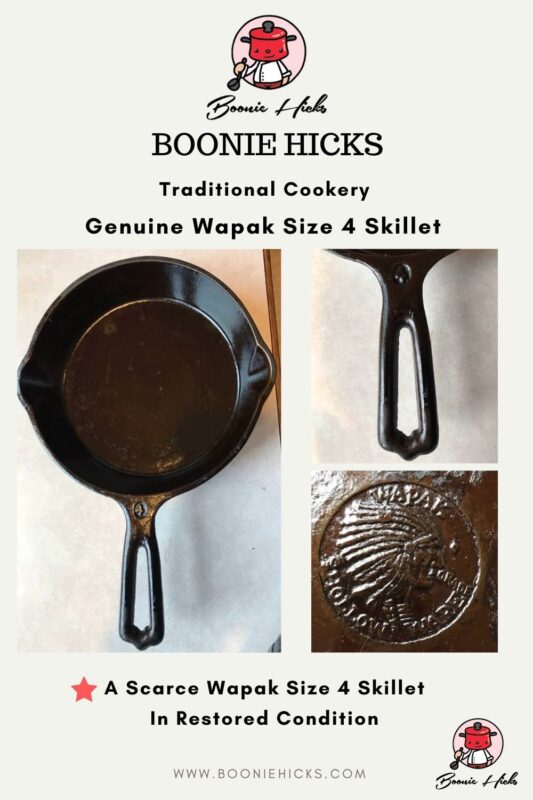
Wobble
Are you purchasing an Indian logo, Wapak? Then, check for movement on a flat surface. Unlike other markings on vintage cast iron, the Indian logo is raised rather than pressed into the ironware. While the logo is undoubtedly appealing, the protruding logo could make a skillet sit unevenly. Therefore, check the ironware for rock or movement on a flat surface.
Is my Wapak fake?
If you think your Wapak skillet is fake, then I have to say it’s unlikely. And antique copies are more scarce than genuine Wapaks. These copies themselves are part of the fascinating history of collecting vintage ironware.
Why do people mistakenly spot a fake?
Mistaking a genuine Wapak for antique imitations comes down to the quality of the logo. However, if the logo lacks detail, this does not indicate a reproduced skillet. As mentioned earlier, the logo may have worn down over the years. And I’ve seen genuine skillets with the Indian marking almost completely smudged out.
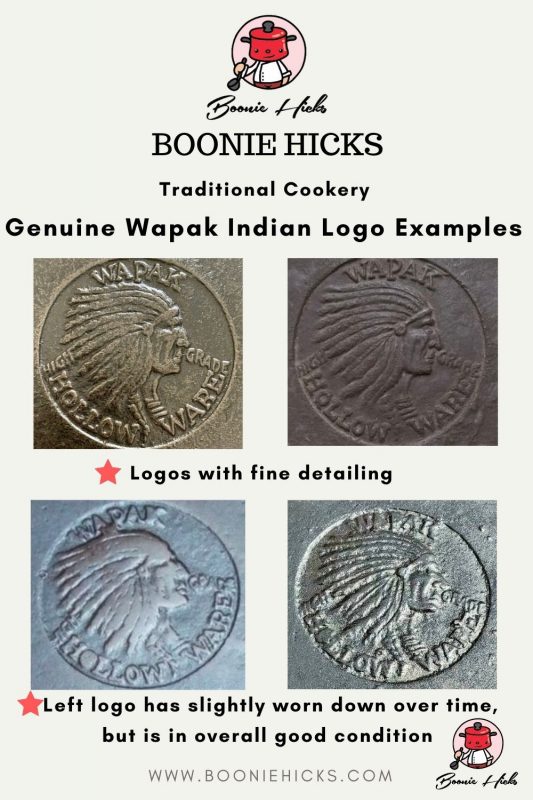
How to spot a copy
Several known imitation skillets and waffle irons are imitations of the original hollowware. Luckily, these imitations are likely vintage and produced without laser-cutting technology. An experienced collector can usually spot a fake by looking at the following details:
- Patchy or uneven casting
- Thinly embossed and or poorly designed logo
- Unusual handle design
Look for poor casting quality.
Genuine Wapak ironware with the Indian logo will be light and smooth. However, modern cast iron and known reproductions are thicker and have a rougher cooking surface.
Lack of detail in the logo
As mentioned earlier, the detail in the Indian logo can wear down over time. But if you notice the design of the logo is considerably different from other Indian logos, you could have a fake. Here are three indicators of reproduction.
- High-Grade marking is illegible due to poor casting
- Facial expression lacks detail, and has an elongated nose
- Headdress lacks detail
Handle design
Another factor in spotting a fake copy of the Indian head skillet is the design of the handle. Genuine skillets have a rectangular-shaped handle rather than the rounded handle on regular skillets. Thankfully, with this oversight, we can identify the most common reproduction. Vintage Wapak copies may have the following:
- A standard style handle on skillets
- Extremely short handle on waffle irons
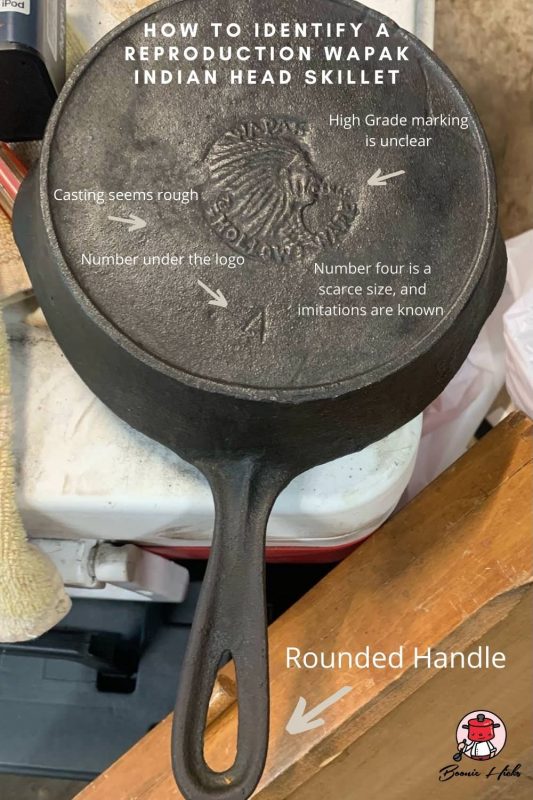
Conclusion
With my writings, I hope buyers and sellers new to cast-iron are realistic in their expectations. These skillets are old, and the logo may be missing fine detail. Luckily, this does not detract from the collectability. However, remember that it is just a frying pan at the end of the day. And far cheaper skillets will cook just as well.
And I trust you can now correctly identify Wapak ironware with the Indian Head logo from imitations. If your ironware is a vintage copy, it’s still part of cast iron history and will add interest to any collection. Understandably, the value of the piece is limited. But I hope you get more from using vintage ironware and place the monetary value a distant second.


